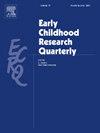情境中的执行功能测量:幼儿园课堂自我调节行为
IF 3.1
1区 教育学
Q1 EDUCATION & EDUCATIONAL RESEARCH
引用次数: 0
摘要
我们研究了两种常用的执行功能(EF)测量方法的效用,以帮助幼儿教育研究人员选择EF测量方法和解释结果:头、脚趾、膝盖、肩膀扩展任务(HTKS-E)和执行功能简要清单-学龄前版本(Brief - p)。为此,我们检查了两种测量方法的收敛效度,年龄和性别的差异,以及与其他重要课堂变量的关系,如幼儿园儿童与教师之间的社会和情感能力以及关系质量。我们还调查了在BRIEF-P筛查中符合EF功能障碍临床临界值的儿童和未达到临界值的儿童在课堂行为和人际关系方面的组间差异。两项量表均与社交能力、情感能力和师生关系质量显著相关。研究发现,幼儿园儿童的情感体验存在差异,情感体验的个体维度与学生课堂行为和体验的不同方面有关。男孩更有可能达到BRIEF-P的临床临界值;这组学生在HTKS-E上的得分明显较低,社交和情感能力较低,与老师的亲密程度较低。他们在课堂上也经历了更大的攻击性和失调行为,与老师的冲突也更多。HTKS-E能够更好地区分英语熟练程度较高的儿童,而BRIEF-P能够更好地识别在课堂上可能需要额外支持的儿童。本文章由计算机程序翻译,如有差异,请以英文原文为准。
Measuring executive functions in context: Self-regulating behavior in the kindergarten classroom
We examined the utility of two commonly employed measures of executive functions (EFs) to aid early childhood educational researchers in their choice of EF measures and interpretation of results: The Head, Toes, Knees, Shoulders Extended Task (HTKS-E) and the Brief Inventory of Executive Functions – Preschool Version (BRIEF-P). To do so, we examined convergent validity of the two measures, differences in age and gender, and relations to other important classroom variables, such as social and emotional competencies and quality of relationships between kindergarteners and their teachers. We also investigated between-group differences in classroom behaviors and relationships of children who met the clinical cutoff on the BRIEF-P screener of EF dysfunction and those who did not. Both measures of EFs were significantly related to social and emotional competencies and teacher-student relationship quality. We found evidence that EFs are differentiated in kindergarten children and that individual dimensions of EFs are related to different aspects of student classroom behaviors and experiences. Boys were more likely to meet the clinical cutoff on the BRIEF-P; students in this group demonstrated significantly lower scores on the HTKS-E, lower social and emotional competencies, and less closeness with teachers. They also experienced significantly greater aggressive and dysregulated behavior in the classroom and more conflict with teachers. Whereas the HTKS-E was better able to differentiate among children with higher EF proficiency, the BRIEF-P was better able to identify children who may need extra support in the classroom.
求助全文
通过发布文献求助,成功后即可免费获取论文全文。
去求助
来源期刊

Early Childhood Research Quarterly
Multiple-
CiteScore
7.00
自引率
8.10%
发文量
109
期刊介绍:
For over twenty years, Early Childhood Research Quarterly (ECRQ) has influenced the field of early childhood education and development through the publication of empirical research that meets the highest standards of scholarly and practical significance. ECRQ publishes predominantly empirical research (quantitative or qualitative methods) on issues of interest to early childhood development, theory, and educational practice (Birth through 8 years of age). The journal also occasionally publishes practitioner and/or policy perspectives, book reviews, and significant reviews of research. As an applied journal, we are interested in work that has social, policy, and educational relevance and implications and work that strengthens links between research and practice.
 求助内容:
求助内容: 应助结果提醒方式:
应助结果提醒方式:


